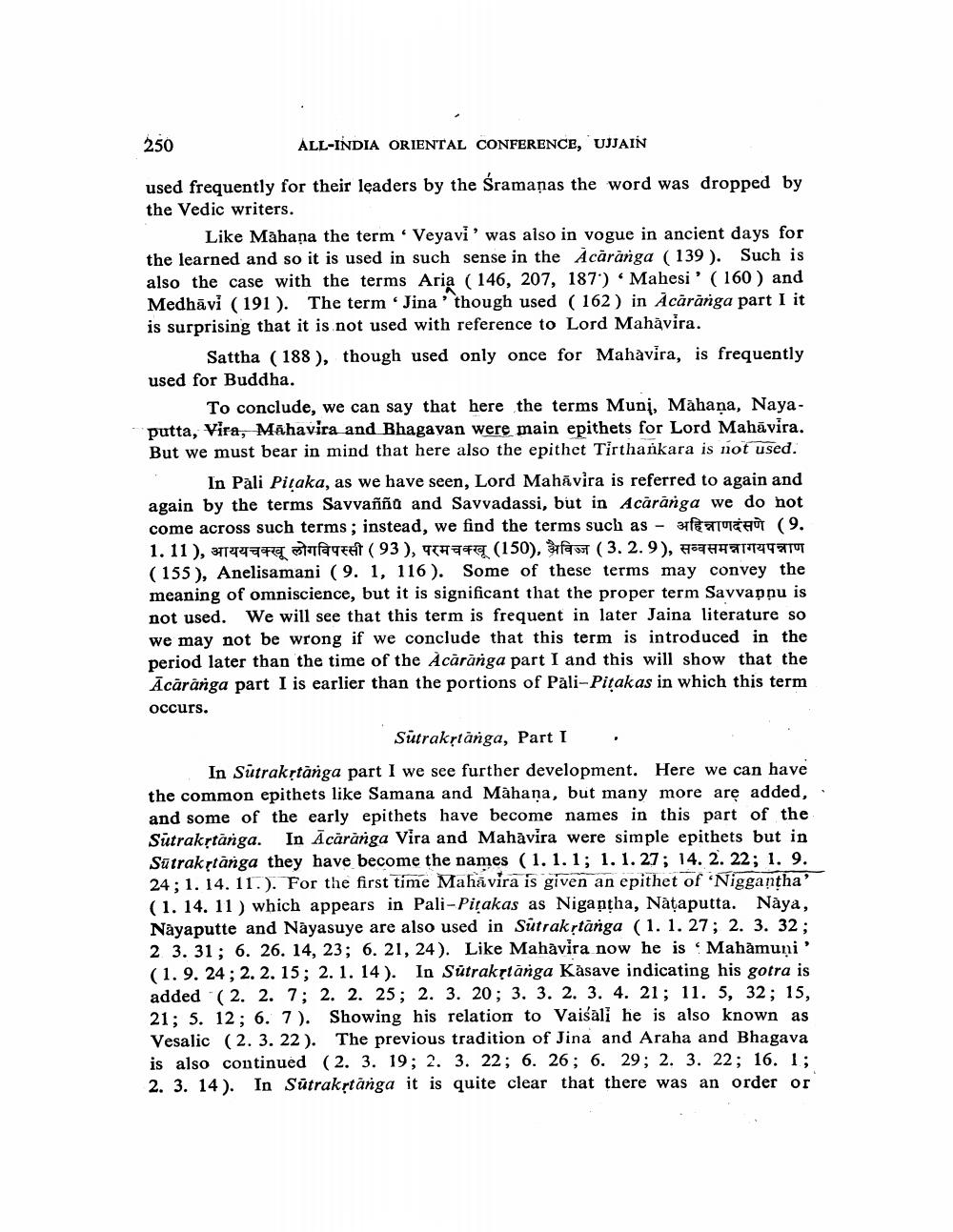Book Title: Epithets Of Lord Mahavira In Early Jaina Canons Author(s): Dalsukh Malvania Publisher: Dalsukh Malvania View full book textPage 4
________________ 250 ALL-INDIA ORIENTAL CONFERENCE, UJJAIN used frequently for their leaders by the śramaņas the word was dropped by the Vedic writers. Like Mahana the term . Veyavi' was also in vogue in ancient days for the learned and so it is used in such sense in the Acäranga ( 139 ). Such is also the case with the terms Aria ( 146, 207, 187) Mahesi ' ( 160 ) and Medhāvi (191). The term 'Jina 'though used (162) in Acărănga part I it is surprising that it is not used with reference to Lord Mahävira. Sattha (188), though used only once for Mahavira, is frequently used for Buddha. To conclude, we can say that here the terms Munj, Mahaņa, Nayaputta, Vira, Mahavira and Bhagavan were main epithets for Lord Mahāvira. But we must bear in mind that here also the epithet Tirthankara is not used. In Pali Pitaka, as we have seen, Lord Mahāvira is referred to again and again by the terms Savvañña and Savvadassi, but in Acărănga we do not come across such terms; instead, we find the terms such as - 3 TU (9. 1.11 ), 312477qfaret (93), THF (150), f ( 3. 2. 9), 1997 (155), Anelisamani (9. 1, 116). Some of these terms may convey the meaning of omniscience, but it is significant that the proper term Savvappu is not used. We will see that this term is frequent in later Jaina literature so we may not be wrong if we conclude that this term is introduced in the period later than the time of the Acaranga part I and this will show that the Ācāranga part I is earlier than the portions of Pali-Pitakas in which this term occurs. Sutrakstānga, Part I In Sūtrakstānga part I we see further development. Here we can have the common epithets like Samana and Māhana, but many more are added, and some of the early epithets have become names in this part of the Sutrakstanga. In Ācāranga Vira and Mahavira were simple epithets but in Sutraktănga they have become the names (1. 1.1; 1. 1. 27; 14. 2. 22; 1. 9. 24; 1. 14.11.). For the first time Mahāvira is given an epithet of 'Niggantha' (1. 14. 11 ) which appears in Pali-Pitakas as Nigantha, Nataputta. Naya, Nayaputte and Nayasuye are also used in Sūtrakrtanga (1. 1. 27; 2. 3. 32; 2 3. 31 ; 6. 26. 14, 23; 6. 21, 24). Like Mahavira now he is Mahamuni' (1. 9. 24; 2. 2. 15; 2. 1. 14). In Sutrakstānga Kasave indicating his gotra is added " ( 2. 2. 7; 2. 2. 25; 2. 3. 20; 3. 3. 2. 3. 4. 21; 11. 5, 32; 15, 21; 5. 12; 6. 7). Showing his relation to Vaisali he is also known as Vesalic (2. 3. 22). The previous tradition of Jina and Araha and Bhagava is also continued (2. 3. 19; 2. 3. 22; 6. 26; 6. 29; 2. 3. 22; 16. 1; 2. 3. 14). In Sütrakrtanga it is quite clear that there was an order or Pali-Pilakas is given an epith: 14. 2. 22;1Page Navigation
1 2 3 4 5 6 7
